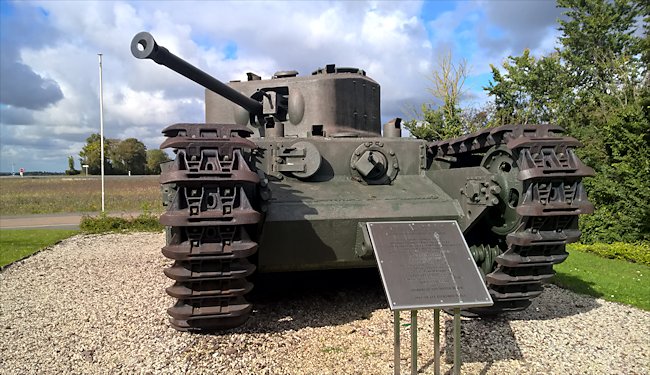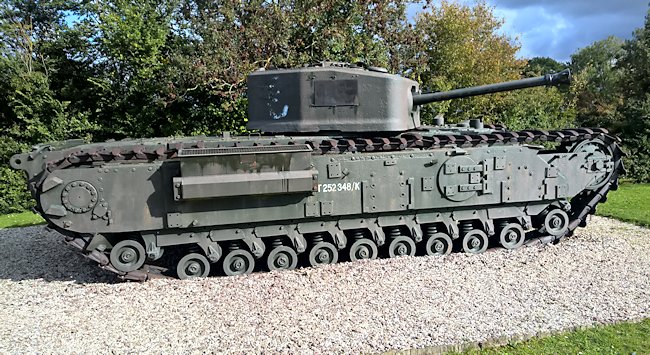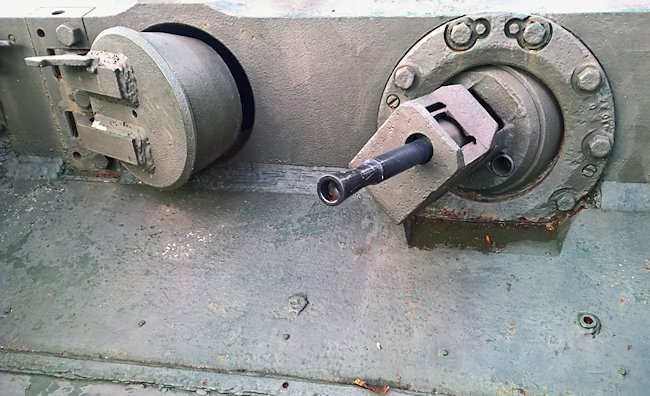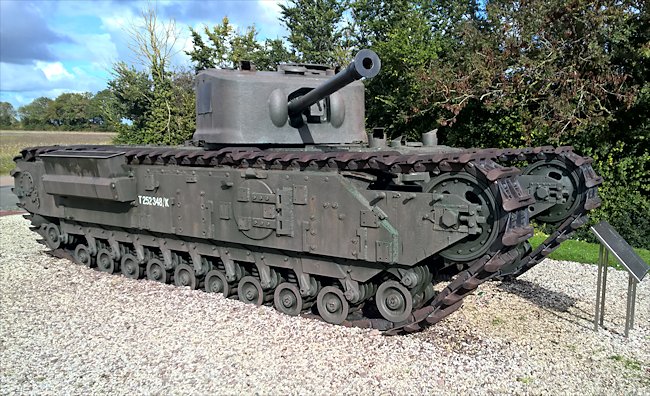Hill 112 Churchill Mk VII Tank
Hill 112 was held the Germans. It had commanding views over the countryside and was fought for by the Allies at great loss of life on both sides. The memorial includes a restored A22 Churchill Mk VII tank with its 75mm gun.

One of the memorial plaques state 'This Churchill tank was acquired and restored by C and C Military Services of Aylesbury England for Mr Albert Figg and has been restored to represent on of the many tanks lost during the battle of Hill 112, 10th/11th July 1944.'
Location
The memorial is on top of the hill and not near any town so it is difficult to locate using a Sat-Nav. The best way of finding it is to type in the town of Eterville and the road Route de Maltot. Drive south east on this road out of town until you come to a roundabout with a major road. This is the D8. Turn right on to the D8 away from Caen heading towards Esquay-Notre-Dame and Evrecy.
The road gradually goes up hill passing a large water tower. About 2km (1.5 miles) further on from the water tower you reach the top of Hill 112. You first see a large round cylindrical storage building in front of a screen of trees on your left. The Churchill Tank and Hill 112 Memorial is behind these trees. It is near the junction of the country road called Chemin Hausse with the D8.

The Churchill tank was very long and designed to cross trenches. Designers in the 1930s believed that the next war would be like WW1.
Specification
The Churchill Mk VII Tank was armed with an Ordnance QF 75mm gun plus two 7.92mm Besa machine guns. One in the hull with a limited arc of fire due to the protruding front tracks and one in the turret coaxial next to the main gun. It was powered by a Bedford horizontally opposed twin-six petrol engine that next to the main gun. It was powered by a Bedford horizontally opposed twin-six petrol engine that produced350350 bhp. The Mark VII Churchill was very slow. It only had a maximum road speed of 15 mph (24 km/h). It needed a crew of 5: tank commander, gunner, loader/radio operator, driver, co-driver/hull machine gunner.
This version of the of the Churchill tank was fitted with more armour than than previous models. It was sometimes referred to as the 'Heavy Churchill'. The armour protection ranged between 25 mm to 152mm which compared favorably to the previous models that only had a armour thickness that ranged from 16mm to 102mm. The armour was vertical not sloped. It only had an operational range of 56 miles (90 km) before it needed refueling. They were manufactured by Vauxhall Motors who produced 7,368. This total figure includes all versions of the Churchill Tank
The Memorial Plaque
There is a large statue of a British Tommy holding his rifle at the memorial. The plaque underneath reads, 'To the memory of all ranks of the 43rd (Wessex) Division who laid down their lives in the cause of freedom June 1944 to May 1945. This Memorial is erected on the site of the battle in which the Division took part July 10th to 29th July 1944 when this ridge, Chateau de Fontaine, Eterville and Maltot were captured and held.'

The front armour of the Churchill tank Mark VII was very thick
Hill 112: Just like Verdun
Near the Memorial statue there is a public information board titled 'Hill 112: Just Like Verdun.' It says, 'Between the valleys of the Rivers Odon and Orne Hill 112, southwest of Caen, is a vantage point overlooking gently undulating ground. From there a vast area can be seen and controlled, including Carpiquet airfield, This high ground, crowned with a thin copse, had definite strategic value. 'Whoever holds Hill 112, holds all of Normandy', it was said.
Operation EPSOM: THE SHARP CHECK (26th JUNE-1st JULY 1944). In the course of this offensive, launched on 26th June, the Scottish of 15th Division crossed the Odon, British 11th Armoured Division advanced as far as Hill 112, but German counterstrokes by the 2nd SS Tank Corps managed to contain the front along the right bank of the Odon.

The side of the Churchill Mk VII tank was protected by an additional slab of thick armour. This tank is missing its track guards
Operation JUPITER: CAPTURING HILL 112 (10th - 11th JULY 1944). The day following the capture of Caen, British 43rd Infanfry Division was given orders to take the height. Opposite, 9th and 10th SS Division had turned the area into a defensive position. By the evening of 10th July, the devastated summit had become Hill 112, the 'Hill of Cornwall' for the British, the 'Hill of Calvary' for the Germans, was the object of continuous fighting in a landscape reminiscent of Verdun. 7,000 men, such was the price paid by the Allies, in the course of a terrible war of position, in order to capture a section of slightly higher ground in the plain of Caen. Hill 112 did not finally fall into British hands until 12th August, with the general withdrawal of the German forces.
The first Operation Epsom attacks on hill 112
On 29th June 1944, the 11th Armoured Division managed to get tanks on to the key position of Hill 112. They held off attacks by leading elements of the 1st SS Panzer-Division Leibstandarte Adolf Hitler, which was supported by the 7th Mortar Brigade with Nebelwerfer and a Kampfgruppe from the 21st Panzer-Division.
At 11.00 hours, the unfortunate Bittrich, having taken command of the Il SS Panzer Corps just the evening before, received orders to advance in one hour. Initially reluctant to mount such a hurried attack, he was then persuaded of the urgency.
The 9th SS Panzer-Division Hohenstaufen received a signal stating the importance of the mission. Without the commitment of both panzer corps, it said, 'the enemy which has broken through to Baron could not be repulsed. They would break through to the Orne and Caen would be lost.' The Panzer Lehr Division was ordered to support the left flank of Bittrich's attack. But their opponents then had a great stroke of luck. The 15th Scottish captured an SS officer carrying the plan.
Their forward battalions rapidly prepared defensive positions. The onslaught of the II SS Panzer Corps began in earnest shortly after midday. At 16.05 hours, its headquarters reported to Panzer Group
West that they had destroyed eleven British tanks in front of Gavrus. Half an hour later they claimed to have taken Gavrus and knocked out twenty-three tanks. Geyr von Schweppenburg, who had returned the day before to assume command with his Panzer Group West headquarters, urged on the two SS divisions at dusk. He told them that this attack offered 'die grosse Chance'. But that night, the 15th Scottish Division, heavily supported by artillery and naval gunfire, fought off the 9th and 10th SS Divisions with spectacular success.
Thirty-eight panzers were knocked out and the SS Frundsberg was forced back to its start line. The effect on the morale of the two SS panzer divisions was even greater. Unfortunately, Dempsey apparently never knew of the intelligence which revealed that this was the main counter-attack. Fearing that a major assault would come on the other flank, he pulled back the 11th Armoured Division instead of reinforcing it. Hill 112 was then rapidly occupied by the Germans. It proved a disastrous mistake. To recapture Hill 112 would take far more time and lives than could ever have been saved by this withdrawal.
Development of the Churchill Tank
At the outbreak of war in September 1939, there was a strong school of opinion at the War Office that conditions on the Western Front would not be very different from conditions experienced in 1914-18. There was therefore a need for a very heavy infantry tank invulnerable to known anti-tank guns, with a very wide trench-crossing ability, and able to negotiate ground churned up by shell fire.
Designated A20, a specification was drawn up by the Superintendent of Tank Design, Woolwich, and Harland and Wolff were asked to build a pilot model. Armour thickness of 80mm, speed of 15mph, ability to climb a 5ft parapet, and a crew of seven were among characteristics requested.
Essentially the A20 was a refinement of the 'lozenge' shape tanks built by the British in 1916-18 ; various combinations of armament were considered including a 6pdr, French 75mm, 3in howitzer, and 2pdr. Finally a 2pdr was selected for the turret, another to be mounted in the nose, with machine guns recessed in the hull side at the front.
Four pilot models were ordered in February 1940. The first pilot model ran trials in June 1940, plagued by gearbox trouble. Data from the first run, however, showed that in order to maintain the required performance the gun armament would have to be reduced to a single 2pdr.
This coincided with the Dunkirk evacuation, when Britain was left with less than 100 tanks for home defence. Vauxhall (the British off-shoot of GMC) were therefore asked to 'refine' the A20 design, scale it down slightly, and get it into production as rapidly as possible, preferably within a year.
Choice of Vauxhall was largely influenced by the fact that their Vauxhall-Bedford twin-six engine was scheduled for the A20. The A20 pilot model and plans were handed over to Vauxhall, extra draughtsmen were loaned by the Mechanisation Board, and a pilot model of the new design, A22, Infantry Tank Mk IV, was ready by November 1940. The first 14 production models were delivered in June 1941 from an order for 500 straight off the drawing board.
Due to the rushed development programme for this vehicle, there were numerous defects in the design leading to frequent breakdowns with the early marks. This necessitated considerable re-work programmes in 1942-43, the secondment of Vauxhall engineers to units equipped with the tank, and numerous detail improvements to mechanical components.
Named Churchill, the A22 was built in quantity by a production group consisting of Broom and Wade, Birmingham Carriage and Wagon, Metropolitan Cammell, Charles Roberts, Newton Chambers, Gloucester Railway Carriage, Leyland, Dennis, and Harland and Wolff, all under the parentage of Vauxhall.
The Churchill was of composite construction consisting of an inner skin of mild steel with an outer covering of armour plate bolted or riveted in position. Initially a cast turret was fitted, but later models had larger turrets of either cast, welded, or composite construction.
The engine and drive were at the rear, and the overall tracks with small sprung bogie assemblies allowed space between the lower and upper runs of track for stowage of ammunition and stores, making the Churchill an unusually roomy vehicle. Escape doors for the crew were fitted in each side. Transmission featured the new Merritt-Brown four-speed gearbox which provided controlled differential steering, the Churchill being the first British tank to have this.
Armament of the Mk I was a 2pdr with a 3in howitzer in the hull front. Changing tactical requirements, however, led to a change of armament through the Churchill's production life. In common with the British cruiser tanks a 6pdr gun was fitted in 1942, necessitating a larger turret (Mk Ill).
Experience in the desert fighting of 1941-42 led the War office to believe that speed and reliability were more important than heavy armour, and it was decided to cease Churchill production in 1943 when the A27 series of cruiser tanks became available.
However, the Churchill's first combat actions, with the 1st Army in the Tunisian campaign, proved most successful in the hilly conditions of the terrain and this earned the vehicle a reprieve. In 1943, the Churchill was again up-gunned (Mk VII) with the new British version of the 75mm gun. At the same time major design improvements were effected. Since it was built to meet British railroad loading guage restrictions, the Churchill suffered from the same disadvantage as other contemporary British designs in that it was too narrow to take the larger turret required for the 17pdr gun. Thus by 1944-45 it was under-gunned by German standards, but this was offset to an extent by the vehicle's heavy armour protection.
The other factor which made the Churchill one of the most important British tanks of 1939-45 was its adaptability to the specialised armour roles needed for the invasion of Europe in 1944. The vehicle's roomy interior, regular shape, and heavy armour made it particularly useful as an armoured engineer vehicle, bridgelayer or recovery vehicle. The many variants built for these specialised roles are also detailed below.
D-Day 1944 books

